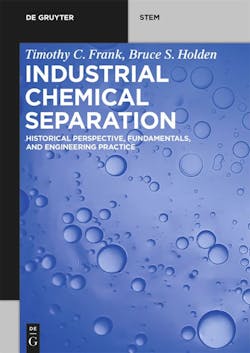Chemical Processing Book Club: Discover Industrial Chemical Separation Insights
What motivated you to write this book?
We wanted to pass along helpful tips that we picked up over the course of many years working with talented engineers and chemists. We also wanted to spread our enthusiasm for this important discipline.
What are some of the fundamental concepts readers can expect to learn from this book?
The book is organized into three parts. Part I covers why we care about chemical separation; Part II reviews fundamental separation concepts and Part III describes separation engineering practice. Of course, as a practitioner, it is important to be thinking about the fundamentals. For example, determining early on whether phase equilibrium is the dominant factor affecting performance or whether the rate at which the system moves toward equilibrium dominates performance is imperative. This understanding focuses the effort toward finding an effective approach to achieving good performance. Also, many separations are accomplished using two or more separation methods in concert (a hybrid scheme), and one way to think about how best to combine methods is to consider which concentration range is best for each – by considering fundamental equilibrium and rate factors affecting their performance. This is explained in Chapter 14.
Can you highlight any challenging topics that your book addresses?
In Chapter 4, we address challenges and opportunities. There are many challenges related to improving product purity and yield (product recovery), improving cost-effectiveness, reducing energy consumption, promoting safety awareness, enabling recycling and upcycling efforts, reducing chemical emissions to the environment, and the list goes on and on. A challenge often in the news today has to do with addressing society’s goal of reducing the concentrations of CO2 and other greenhouse gases in the atmosphere. Many of the initiatives already underway involve the development of advanced separation methods.
Were there any specific gaps in existing resources that you aimed to fill with your book?
We wrote the book as a complementary companion to the many excellent references and textbooks already available – one that describes popular technologies from a practitioner’s (or industrial) point of view. So, we included some topics not emphasized in most textbooks, such as a review of the history of technology development (the engineering tradition) and how specific molecular interactions can impact phase equilibrium. We tried to describe how popular separation technologies function in practical terms, with less emphasis on equations.
Please share any practical examples or case studies that readers might find valuable.
We included some examples in the book but did not include detailed case studies, in part because doing so might require disclosing proprietary information about projects we worked on in our careers. However, the general recommendations we offer are based on long-time experience working on many separations.
Apart from your book, what other resources or references do you recommend to readers who want to continue learning about this topic?
There are many excellent references and textbooks, and we hope our book adds some helpful insights to the discussion. Regarding recommended references, a good place to start is a favorite separations textbook plus Perry’s Chemical Engineers’ Handbook. We list many other resources in bibliographies following each of the three parts of the book.
Have you received any feedback from readers or professionals in the field about how your book has helped them?
We have received some positive comments from people we know from our time working in industry. And we would like to hear from readers in general with comments and/or corrections. Readers should feel free to contact us at the e-mail addresses given in the front of the book.
What impact do you hope your book will have on readers?
We hope readers will appreciate the importance of their role in devising, operating and improving separation technologies. This engineering discipline is critically important in the making of essentially all finished goods and formulated products. We also hope readers will enjoy reading about how the technologies have developed over the years and find our discussion helpful in their work. And we hope they will enjoy the poem at the front of the book and our occasional references to music as a fun analogy.
About the Author
Traci Purdum
Editor-in-Chief
Traci Purdum, an award-winning business journalist with extensive experience covering manufacturing and management issues, is a graduate of the Kent State University School of Journalism and Mass Communication, Kent, Ohio, and an alumnus of the Wharton Seminar for Business Journalists, Wharton School of Business, University of Pennsylvania, Philadelphia.


